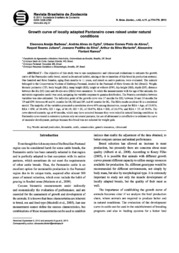Growth curve of locally adapted Pantaneiro cows raised under natural conditions.
Growth curve of locally adapted Pantaneiro cows raised under natural conditions.
Autoria: BARBOSA, E. A.; EGITO, A. A. do; ABREU, U. G. P. de; JULIANO, R. S.; SILVA, J. P. da; MARIANTE, A. da S.; RAMOS, A. F.
Resumo: The objective of this study was to use morphometric and ultrasound evaluations to estimate the growth curve of the Pantaneiro cattle breed, raised in its natural habitat, aiming at the re-insertion of this breed in production systems. One hundred and three females, aging from months to 11 years, and raised on native pastures, were evaluated. The animals belonged to the Conservation Nucleus of Embrapa Pantanal, located in the Pantanal of Mato Grosso do Sul (Brazil). Weight, thoracic perimeter (TP), body length (BL), rump height (RH), height at withers (HW), hip height (HH), depth (DP), distance between the ilia (DI) (cm) and rib-eye area (REA) were measured. To relate the measurements with the age of the animals, the univariate regression model was used, assigning the variable response to gamma distribution. The Pearson correlation between variables was also estimated. The inflection point of the growth curve was 37 months for HH; between 38 and 39 months for TP and HW; between 40 and 41 months for DI, HH and DP; and 45 months for BL. The REA results could not fit in a statistical model. The majority of the variables presented a correlation above 60% among themselves, except for REA × Age, of 15.81%; REA × HW, of 34.44%; HH × Age, of 46.19; HH × DI, of 58.07%; REA × HH, of 24.57%; and REA × TP, of 39.9%. The cows showed maturity age at 40 months, which may have occurred because they were raised in natural farming conditions. In Pantaneiro cows reared in extensive systems only on natural pastures, the use of ultrasound is not effective to estimate the curve of muscular development, perhaps because this breed was not selected for weight gain.
Ano de publicação: 2013
Tipo de publicação: Artigo de periódico
Palavras-chave: Biometric, Conservation, Ultrasound, animal production, cattle, genetic resources
Observações
1 - Por padrão são exibidas publicações dos últimos 20 anos. Para encontrar publicações mais antigas, configure o filtro ano de publicação, colocando o ano a partir do qual você deseja encontrar publicações. O filtro está na coluna da esquerda na busca acima.
2 - Para ler algumas publicações da Embrapa (apenas as que estão em formato ePub), é necessário ter, no celular ou computador, um desses softwares gratuitos. Sistemas Android: Google Play Livros; IOS: iBooks; Windows e Linux: software Calibre.
Acesse outras publicações
Acesse a Base de Dados da Pesquisa Agropecuária (BDPA) para consultar o acervo completo das bibliotecas da Embrapa.

